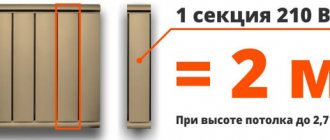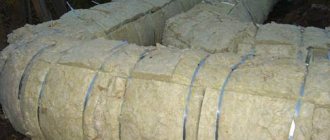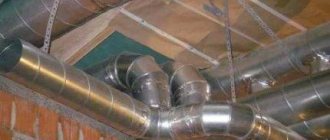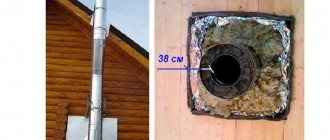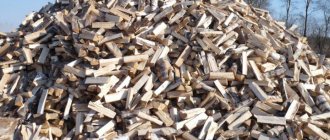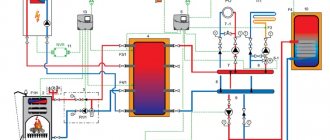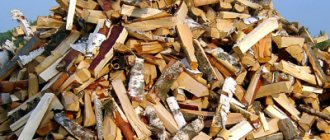Factors affecting the level of solid fuel consumption
It will not be difficult to calculate how much a solid fuel heating boiler consumes. It is more difficult to correctly select the initial data for performing calculations.
The following is the calculation methodology and at the same time the calculation of the consumption of the amount of firewood for heating a dwelling of 100 m² is given. However, let's look at the initial data first:
- the type of wood that is selected for kindling;
- the degree of moisture in the wood;
- efficiency of a solid fuel furnace or boiler;
- thermal power required to heat the room.
If you have ever used a stove, then, for sure, you are aware that when burning firewood, different amounts of heat emanate from different trees. Let's say birch logs emit more heat than poplar or pine. This is due to the difference in density and heat output of the tree species. In addition, the volume of firewood per 1 kW of heat energy depends on the moisture content in them. Accordingly, the higher the humidity, the more heat is spent on the evaporation of liquid from the wood, and less is left for heating the dwelling. As a result, more fuel will be consumed to heat the house.
How rationally the energy in the fuel will be used depends on the efficiency of a particular heat source. For example, a fireplace or stove emit most of the energy into the atmosphere along with the combustion products, therefore, their heat transfer reaches only 60%. At the same time, a solid fuel or pyrolysis (long burning) boiler operates with a heat output of 80%. These nuances should be taken into account when calculating the cost of heating a home.
The value of the thermal power required to heat the house is best taken according to the calculation made by the craftsmen during the design period of the dwelling. However, these data are often not kept by the property owners. Therefore, the amount of firewood and their cost can be found by the average value of the power consumption. It is determined in a standard way: 1 kW of heat is consumed for heating 10 m² under the worst conditions, and the average for the season is 0.5 kW. The average figure for a 100 m² dwelling will be 5 kWh.
The amount of firewood for the winter, the mathematical calculation of how much firewood is needed to heat the house
One of the paradoxes of the universe: the more ordinary and familiar an object of natural origin, the more complex its mathematical description. In order to calculate the volume of a Galaxy or a star, it is enough to remember the school geometry course. If someone really needs to know the exact volume of a log, it is impossible to do without methods of differential calculus. From the astronomer's mistake, the layman is neither hot nor cold; but with an incorrect calculation of fuel reserves for the winter, the cold in the house is ensured.
Everything seems simple: the duration of the heating season in days is multiplied by the area of the house and by the average daily consumption of firewood. Do not believe this simplicity, it is deceiving and requires a lot of clarifications. In fact, it is necessary to take into account the ceiling height, i.e. not area, but volume. The fun begins when it comes to the average daily consumption of firewood.
This value depends on the calorific value of the fuel, the efficiency of the stove, climatic conditions, heat loss and many other factors, including the radius of curvature of the hands of the master. The last parameter is an irrational value that can reduce heating efficiency to zero. If you set yourself the goal of deriving a universal formula for an accurate calculation, there will be enough material for more than a dozen theses. It is much faster to make inquiries with neighbors or former owners of the house.
If you plan to install a solid fuel boiler, it is easier to calculate its "appetite" - the main technical characteristics are known. The easiest way to get an approximate figure is using formulas or online calculators posted on specialized sites.
Let's try to calculate.
150 m² • 50 W / m² • 24 hours • 214 days = 38.52 MW • h, which approximately corresponds to 33 Gcal.
The specific net calorific value of absolutely dry wood is 4440 kcal / kg. With natural drying for about two years, the residual moisture content of the wood is 20%, the specific heat of combustion is 3400 kcal / kg. We will take the efficiency of a solid fuel boiler as 70%.
We calculate the required amount of firewood: 33000 kcal • 1000/3400 kcal / kg / 0.7 / 0.730 kg / m³≈19 m³, where 0.730 kg / m³ is the density of oak wood. In terms of maple or birch, the required value is 21.3 m³, for pine - 26.4 m³. In practice, less or more firewood may be needed, depending on the state of the house's insulation and the weather.
All-knowing statistics claim that 4-6 cubic meters of firewood per season is quite enough for heating a small insulated log house in central Russia. The most economically justified stock of firewood for two or three seasons: current 1-2 next. In this case, you will probably have enough fuel even for the most prolonged cold period. Another reason: firewood, like good alcohol, only gets better over time.
“God have mercy, what kind of wood? We are civilized people, we have gas! " - this position is fundamentally wrong. Firstly, because we were lucky enough to live in the most amazing country in the world. here from time immemorial, two scenarios have been observed: the unlikely and the worst. Secondly, the civilized world is returning to proven and, most importantly, renewable energy sources. Firewood, straw and peat are the same as hundreds of years ago, adjusted for modern technology.
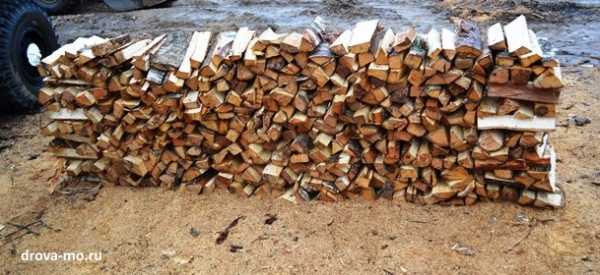
Having a solid fuel boiler and at least a year's supply of firewood in a gasified house is not a whim, but a completely reasonable decision. Optimism is good, but twice as good - optimism backed by strategic reserves.
You can also use our online calculator for calculating the amount of chopped wood for heating a country house, cottage or bathhouse.
Not all rural residents are lucky enough to install gas or electric heating. Many people still use wood to heat their stoves and boilers. Those who have been doing this for a long time know how much stock they need. People who have recently moved to the countryside are interested in the question of how firewood is prepared for the winter and how much they need to be chopped.
Calculate how much firewood you need, at least approximately. After all, it's good when you can chop up extra logs at random. And suddenly there will be few of them and then this hard work will have to be completed in winter in the frost.
We suggest you familiarize yourself with: How to keep cut flowers fresh for the bouquet to last longer
Advice! If you have access to the Internet, calculate the required amount of firewood using a special calculator. In this online program, you just need to enter data in the windows and it will give you the correct result itself.
It is necessary to independently calculate the amount of firewood for heating a house, taking into account many factors. Here they pay attention to the efficiency of a wood-burning boiler or stove, the size of the heated room and the duration of the heating period. But first you need to find out which firewood is better for heating, because each type of wood differs in heat transfer due to its different density.
Let's take a closer look at the factors affecting the calculation:
- Humidity affects the heat transfer coefficient. Anyone knows that dry wood burns well, which means that it gives off more heat. If firewood was collected in damp weather or sawed green trees, then it is advisable to store the chopped logs in a ventilated barn. It makes sense here to make blanks for two years.During the season, the stock of firewood will dry out, and the coefficient of their moisture content will be no more than 20%. These logs should be used. Another fresh chopped stock will dry up until next season.
- The heat transfer coefficient depends on the type of wood. The best logs are hardwoods such as oak, birch or beech. Dense wood burns longer and gives off more heat. Pine is less dense. It is better to use such wood for ignition. Pine logs are also suitable for a home with a fireplace. When burned, an aroma is released that fills rooms with the scent of essential oil. If there is an opportunity, then it is necessary to harvest firewood from different types of wood. The combination of logs during combustion can achieve maximum heat transfer and less soot clogging of the chimney.
- The amount of firewood is calculated not by the area of the room, but its volume is taken into account. After all, heating a house with an area of 100 m2 and a ceiling height of 2 m will turn out faster than a building of the same size, but 3 m high.Usually, when making calculations, the ceiling height is taken as the norm - 2.8 m.
- When calculating the required amount of cubic meters of firewood, you need to take into account the duration of the heating period. Moreover, they take into account the year with cold autumn and late spring. For most regions, the heating period lasts up to 7 months. In the south, the cold season can be limited to 3-4 months.
- When calculating the amount of firewood for the winter, it is important to take into account the efficiency of the heater. The most effective are pyrolysis boilers. The bridging furnaces are characterized by high heat losses. The more heat goes out through the chimney into the street, the more often new logs will have to be thrown into the firebox.
Using these simple rules as a basis, you will be able to calculate the optimal amount of firewood.


Advice! When buying a house, ask the old owners how much solid fuel they spent during the heating season.
The calculations, taking into account the average values, show that to heat a house with an area of 200 m2, up to 20 cubic meters of firewood are needed. Now we will try to figure out how to calculate the required stock without an online calculator. We will take as a basis the efficiency of the heating device - 70%. We take a house with a standard ceiling height of 2.8 m.
To achieve this result, you must:
- birch logs with a moisture content of 20% after a year of storage in a shed - up to 1.7 m3;
- freshly cut birch logs have a moisture content of 50%, and they need about 2.8 m3;
- dry oak firewood needs about 1.6 m3;
- oak logs with 50% moisture content will need up to 2.6 m3;
- pine logs with a moisture content of 20% - no more than 2.1 m3;
- firewood from wet pine - about 3.4 m3.
For the calculations, the most common varieties of trees were taken. Using this data, you can find out how much firewood you need to chop. If the harvested mass of solid fuel is consumed earlier than the expected time, then the heat loss of the building is high or the heating device has a low efficiency.
Harvesting firewood for the winter is more than just cutting down a tree and chopping it into logs. It is necessary to provide optimal storage conditions to ensure good drying of the wood. In addition, you need to know that the most optimal time of the year for these works is the end of autumn and the beginning of winter. But the weather should not be rainy. The choice of such a period is due to the following factors:
- cutting down trees without foliage is easier;
- after the first frost, the chocks are easier to split;
- in late autumn, the movement of sap stops, which makes it possible to obtain wood with a lower percentage of moisture.
The entire forest cut down at this time of the year is cut into pieces, chopped, and the logs are sent for long drying until next autumn. You should not immediately throw them into the stove or boiler. Only a lot of soot can be obtained from raw solid fuel, which will settle in the chimney as soot. Logs from last year's harvest are used for heating.
Important! There are a number of modern technologies that can speed up the drying process of raw wood.It is advisable to resort to them in extreme cases. Natural drying results in better quality logs that give good heat when burned.
We suggest that you familiarize yourself: Why do rabbits have eyes swimming
When harvesting firewood, it is not necessary to cut the forest yourself. After all, then these logs still have to be transported home. There are many companies that provide this service. For very lazy people, hired workers can split the logs into chocks. In this case, own labor costs will decrease, but the cost of solid fuel will increase.
Calculation of firewood consumption by a long-burning boiler
To calculate the consumption of firewood in a solid fuel boiler for long burning for a day, use the following formula.
V = 24Q / (q x 0.01KPD) V - means the volume of firewood required for 1 hour, m³; Q is the required power for heating, kW; q - heat output of a certain type of wood with a specific degree of moisture, kW / m³; Efficiency is the boiler efficiency, in%.
Let's say you purchase a solid fuel pyrolysis boiler with a heat transfer rate of 75%. Load dry pine logs. The calculation will look like this.
V = 24 x 5 / (2166 x 0.01 x 75) = 0.074 m³.
Samples to carry out the correct calculation of fuel consumption in a pyrolysis boiler, you need to remember about the nuances of its work. The efficiency of 75-80% is displayed in the formula if the wood has a maximum moisture content of 25%. If the indicator is higher, then the boiler efficiency drops to 70%.
The consumption of firewood in a solid fuel boiler of long burning for a month is done as follows:
0.074 x 30 = 2.22 m³
However, this is not the final result, since the formula uses the calorific value for "clean" m³, and in reality, firewood in the woodpile takes up more space due to the density of the stacking. To correctly calculate the firewood in cubes, you need to know the number of storage meters.
GOST 3242-88, where the standard is indicated, will help to carry out these calculations. In this regard, the folded firewood must be measured, the storage meters must be calculated, and then converted into dense meters, m³. the translation is made by multiplying the volume of the woodpile by the value of full wood.
Wood content coefficients for converting a fold measure close to
| Length, m | Conifers | Hardwood | ||||||
| Round | Split | A mix of chopped and round | Round | Split | A mix of chopped and round | |||
| Thin | Average | Thin | Average | |||||
| 0,25 0,33 0,50 0,75 1,00 1,25 1,50 2,00 2,50 3,00 | 0,79 0,77 0,74 0,71 0,69 0,67 0,66 0,64 0,62 0,61 | 0,81 0,79 0,76 0,74 0,72 0,71 0,703 0,68 0,67 0,65 | 0,77 0,75 0,73 0,71 0,70 0,69 0,68 0,66 0,64 0,63 | 0,77 0,75 0,73 0,72 0,70 0,69 0,68 0,67 0,66 0,65 | 0,75 0,72 0,69 0,65 0,63 0,61 0,60 0,58 0,56 0,55 | 0,80 0,78 0,75 0,72 0,70 0,68 0,67 0,65 0,63 0,62 | 0,76 0,74 0,71 0,69 0,68 0,67 0,65 0,63 0,62 0,60 | 0,76 0,74 0,71 0,69 0,68 0,67 0,66 0,65 0,64 0,63 |
Since in our case there is an inverse problem, the fuel volume calculated above must be divided by one of the coefficients that corresponds to the present conditions.
Let's say you take chopped wood 0.5 m long. For conifers, you need to take an indicator of 0.73. At the end, we calculate the real consumption of solid fuel from dry pine for a month for a dwelling with an area of 100 m²:
2.22 m³ / 0.73 = 3.04 m³
What you need to know to calculate
How much firewood is needed to heat a house depends on several factors:
- the amount of thermal power spent on heating;
- operated equipment;
- varieties of wood;
- moisture content of the tree.
According to the standards, the amount of heat output is 1 kW of heat per 10 sq. m in extreme cold. The average value is 0.5 kW. Thus, for a building of 100 sq. m, it will be 5 kW.
The more spacious the dwelling, the higher the fuel consumption. The efficiency of heating devices of different types is different. For most solid fuel boilers, this parameter reaches 70–75%. Pyrolysis models are more efficient - their efficiency reaches 80%. The lowest heat output is for Russian and steel stoves. Their efficiency is on average 65%, 55%, respectively.
Deciduous, coniferous species are used for heating. The birch has the highest heat transfer - 2371 kW / cu. m at 50% moisture content and 2716 kW / cu. m at 20% water content. The minimum calorific value of the tree is 1667 kW / m3 at a humidity of 50% and 1902 kW / m3 at a moisture content of 20%.
| Wood species | Calorific value of freshly cut wood 50% moisture, kW / m3 | Calorific value of semi-dry wood 30% moisture | Calorific value of dry wood 20% moisture, kW / m3 |
| Pine | 1900 | 2071 | 2166 |
| Birch | 2371 | 2579 | 2716 |
| Spruce | 1667 | 1817 | 1902 |
| Aspen | 1835 | 1995 | 2117 |
| Alder | 1972 | 2148 | 2244 |
| Ash | 2550 | 2774 | 2907 |
Table 1. The calorific value of firewood of different species, referred to the measure of volume - 1 m³.
Preparing for wintering, you need to know how to calculate the cubes of firewood. For this, special formulas have been developed that allow you to calculate the norm of logs for the autumn-winter season.
Algorithm for calculating coal consumption
A modern-type boiler can efficiently operate both on hard coal and on drill. But if there is a choice, then it is better to choose high quality coal - anthracite. It is he who is characterized by the highest thermal capacity and burns out almost without residue. However, the cost of anthracite is higher than other varieties. It is necessary to consider the price of fuel, delivery and its heat capacity, and choose the best option.
Which coal to choose for heating in a private house?
There are two ways to calculate the consumption of coal in a solid fuel boiler. The very first one is elementary, with the help of a bucket. Usually coal is measured in tons, however, it is unlikely that your boiler room will have a scale to accurately weigh the required dose for loading.
One bucket holds about 18 kg of hard coal.
Approximately, to heat a dwelling of 200 m², the following amount of corner will go:
- In September-October, one bucket per day.
- From November to February - 10 buckets.
- In March-April there are about two buckets.
If you take that there are 30 days in a month and add up all the values, you can find out the total number of buckets (780 buckets). In kilograms it turns out:
780 x 18 = 14040 kg
Thus, during the heating season for heating a dwelling of 200 m², a coal-fired boiler will consume a little more than 14 tons of coal.
The second way to calculate the consumption of coal in a solid fuel boiler is more scientific. Combustion of 200 g of coal will consume about 1 kW of heat. For a comfortable stay during the heating period, you need approximately 50,000 kW of heat:
50,000 x 0.2 = 10,000 kg (10 tons)
Algorithm for calculating the consumption of pellets
A wood pellet boiler is especially relevant for residents of those regions who do not have the ability to heat their house with gas. Pellets are produced from waste of the wood processing industry, therefore they are an environmentally friendly type of fuel and, moreover, with a fairly high efficiency.
About what pellet boilers are good for and about their disadvantages, it is written here.
Roughly, to calculate the consumption of pellets for heating a house of 100 m², you can use the following formula. The number of granules is equal to:
70 W / m² x 100 m² x 24 hours x 180 days x 0.7 / 5000 W / hour = 4234 kg 70 W / m² is an indicator of heat loss for 1 m² of the house; 100 m² - the area of the house; 24 hours - hours in a day; 180 days are the days of the heating season; 0.7 - boiler load value; 5000 W / h is the amount of heat generated by the combustion of 1 kg of high quality pellets.
Again, these calculations are approximate. There are many nuances due to which the values can vary.
It is safe to say that it is not difficult to calculate the need for a solid fuel boiler in the amount of fuel. The main thing is not to confuse all the data, but at the end, multiply the resulting cubic meters by the cost of fuel in your area. Remember that when ordering firewood, it is better to clarify the measures used by the supplier: these are storage meters or "pure cubic meters". Otherwise, you risk making a mistake and thereby overpaying or receiving less firewood.

